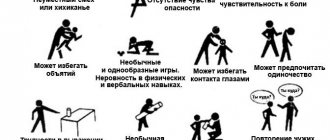Difference between derealization and other mental illnesses
According to medical statistics, about 3% of the world's population suffers from derealization to one degree or another. In patients with schizophrenia, this is one of the main signs of the disease. Symptoms of derealization are observed in almost every drug addict who is “under a dose.”
And yet, this state of mind differs from similar diseases. Thus, with derealization, visions of non-existent objects or actions do not occur, as with hallucinations. There are also no illusions about what is visible and what is heard. Dereazization differs from schizophrenia in the absence of any mania, mental automatism of obsessions.
Reasons for derealization
Derealization syndrome mainly manifests itself in a complex manner and has similar causes to many psychosensory disorders. Strong derealization is most characteristic of pathologies from the list of major psychiatry. Often this can become a manifestation of the schizophrenic process and may not be considered very favorable. In paranoid schizophrenia, derealization is possible in combination with Fregoli syndrome and Capgras syndrome. This can be considered a complication, since more often than not the orientation is preserved.
Severe derealization can occur during clouding of consciousness with productive symptoms. Such manifestations are very characteristic of oneiric hallucinatory stupor. Oneiroid is often accompanied by derealization with alienation from the outside world and duality of events experienced by the individual. Schizophrenia of more severe types may also be accompanied by catatonic, hebephrenic inclusions. Disorganized schizophrenia often changes perception and leads to derealization. Strong derealization is typical specifically for severe types of schizophrenia.
Derealization syndrome is becoming a frequent companion to epilepsy. This syndrome forms after seizures, and sometimes before. Often this manifests itself like an aura, at moments when the individual is not oriented in the environment. Absence seizures with a complex course can also end in derealization, turning into it. Derealization syndrome can be considered the equivalent of an epileptic seizure; its formation occurs on the principle of the formation of convulsions, but since the focus is not in the convulsive zone, the equivalent of a seizure occurs with confusion and derealization.
In fact, almost all psychiatric diagnoses can be complicated by derealization. Dementias may also have this syndrome in their structure, especially when spatial orientation is impaired in a demented individual. Derealization in such individuals is dangerous due to the possibility of ending up in unforeseen situations due to a violation of orientation in space. Dementia is a syndrome that develops as a result of a number of pathologies. Disorders leading to dementia include: Creutzfelt-Jakob dementia, frontotemporal dementia, of which Pick's disease is a component, dementia with the presence of Lewy bodies, Alzheimer's disease.
Not only schizophrenia itself with its subtypes may have derealization in its structure, this syndrome may also be characteristic of schizophrenia spectrum disorders, such as schizotypal and schizoaffective disorders. Affective disorders that reach the psychotic register may also have a pathology in their structure, which is accompanied by derealization.
Derealization can develop in psychoses of somatic origin. Often in children with infectious lesions this condition can form. Also, such a danger can occur with endocrinological pathologies; if neglected, they can often be accompanied by similar symptoms. The risk is especially high for cortisol disorders, thyrotoxicosis, and diabetes mellitus.
Infections can be dangerous in terms of the formation of derealization not only in children. Severe derealization can occur with brain lesions. Such lesions include Koch's bacillus, meningococcus, and Treponema pallidum when progressing to later stages. Viruses that are tropic to the tissues of the nervous system and others: herpes viruses, prion lesions. Fungal infections with decreased immunity can also have this effect.
Derealization syndrome can manifest itself as a result of organic lesions, injuries or tumors. Strong derealization often develops with the abuse of various illegal substances and with the development of dependence syndrome.
Correct treatment
Is an alienated perception of the world dangerous? Yes, sure. This condition should not be ignored in the hope that it will go away on its own. In fact, the consequences can be quite dire.
This is why people are interested in how to get rid of derealization. This is quite real. First of all, you will need:
- try to pull yourself together;
- do not panic;
- accept the changed perception (that is, do not deny it) and seek help from a medical professional.
The doctor must determine the degree of the disorder that has occurred (usually the Nuller technique is used for this). The psychotherapist pays primary attention to the symptoms and causes of the disease.
Is derealization condition treatable? Quite. It is even worth mentioning the main techniques used for this purpose:
- medicinal;
- psychotherapeutic.
In general, it is recommended to treat a permanent disorder with a complex, that is, with both methods.
For example, among medications, doctors usually prescribe drugs that are aimed at combating depression. Treatment with antidepressants may also be accompanied by the use of vitamin supplements and sedatives.
In severe cases, when these medications do not help, the doctor prescribes tranquilizers. It is also possible to prescribe inpatient treatment in the psychoneurology department.
How to treat derealization using psychotherapeutic methods? Psychotherapists usually resort to:
- psychoanalysis;
- hypnosis;
- cognitive behavioral therapy.
With the help of psychoanalysis, it is possible to determine the causes of the syndrome. Various techniques are used in this matter - for example, free associations, transference analysis, and so on. In principle, such therapy is effective, but it takes a lot of time. Sometimes years pass before a person completely gets rid of derealization attacks.
Cognitive-behavioral treatment aims to restore emotional, cognitive and behavioral levels. To overcome the feeling of this syndrome, the doctor restores the patient’s thought processes and improves his emotional state. Muscle relaxation can be used for this purpose (it miraculously helps eliminate muscle tension). When the therapeutic course is completed, the patient must learn to block attacks.
Finally, hypnosis is another answer to the question “what to do with the disease being described?” It corrects distorted perceptions and helps cope with the main symptoms of the disorder.
Derealization in neurosis and other conditions turns out to be quite curable, but this will require the help of a professional psychologist and psychotherapist.
Complex of provoking reasons
Derealization is considered a fairly common disorder, it is observed in more than 4% of people, and the number of patients is growing all the time. It often acts as a human defense mechanism in stressful situations, during various shocks and experiences. Most often, this perception disorder occurs in individuals of both sexes under the age of 25, that is, during the period of formation and self-determination.
The disorder is most often observed in extroverts who are overly impressionable and emotional. There is a high risk of attacks of disorder in individuals prone to perfectionism and having an inflated level of aspirations.
Among the main reasons causing the development of derealization are:
- Biochemical reasons . The patient’s body produces insufficient amounts of dopamine, serotonin, norepinephrine, which regulate the functioning of the psycho-emotional sphere and are responsible for the feeling of pleasure and positive attitude. The cause may also be a lack of gamma-aminobutyric acid, reduced function of the neural opiate system. Heredity. The tendency to pathological anxiety can be genetically determined, and be a kind of “family” way of reacting to stressful situations.
- Personal and psychological reasons . The development of the disorder can be caused by the presence of such individual human traits as impressionability, suspiciousness, increased demands on oneself, vulnerability, perfectionism, pedantry, and a tendency to fixate on negative situations.
- Somatic causes . The development of derealization can be triggered by the presence of the following diseases in an individual: hypoglycemia (low blood glucose levels); some diseases of internal organs; pathological processes in internal organs; hyperthyroidism (excessive thyroid function); diseases of the respiratory system; pheochromocytoma (a hormonally active tumor, most often located in the adrenal medulla); mitral valve prolapse.
- Social reasons . The disorder can develop as a result of an unfavorable family situation, childhood psychological trauma, a conflict situation in an educational or work community, the death of loved ones, the presence of a protracted or incurable illness, divorce, or lack of emotional support.
- Dependencies . Risk factors for the development of the syndrome are drug and alcohol addiction, smoking, and use of psychoactive substances.
- Lack of a healthy lifestyle . Lack of sleep, poor quality sleep, lack of proper rest, improper work schedule, mental and physical overload are also favorable conditions for the development of the disorder.
Article on the topic: Bloating and gas formation - causes and treatment in men and women with medications and folk remedies
Derealization is rarely the only disorder in an individual, and often it accompanies depersonalization, VSD, panic attacks, and schizophrenia.
Derealization and cervical osteochondrosis
Osteochondrosis is a chronic pathology that affects the discs between the vertebrae and cartilage. The disease usually develops after 40 years of age.
Symptoms of the disease appear from the age of 20. Osteochondrosis is considered one of the main causes of back pain. During the course of the disease, blood supply and metabolism in the spinal column are disrupted.
At the initial stage, intervertebral discs lose their elasticity, strength and become depleted. The fibrous ring ceases to withstand the load on the spine and over time begins to crack and bulge.
With the development of degenerative processes in the spine, comprehensive treatment is necessary. Osteochondrosis cannot be stopped with medications alone. Therefore, in addition to drug therapy, massage and gymnastics, such patients are necessarily prescribed physiotherapeutic procedures. One of the most effective is acupuncture. This method of treatment, also known as acupuncture or acupuncture, comes from Eastern medicine, where it has been popular for thousands of years.
Acupuncture for cervical osteochondrosis is now considered the safest and most effective procedure. It helps relieve pain and restore mobility of the spine. According to reviews from patients who have undergone acupuncture, this type of treatment helped them return to normal life and relieved them of suffering.
The method of treating various diseases by influencing acupuncture points came to us from China. Eastern medicine specialists have determined that the entire human body is permeated not only with blood vessels and nerves, but also with channels through which energy flows. These channels extend to the surface of the skin, forming acupuncture points.
In oriental medicine there are many methods of such influence, but the most popular is the use of needles. For this purpose, special thin needles with rounded tips, made of silver, gold or stainless steel, are used. This effective treatment method has recently begun to be used in European countries.
For any disease, it is very important to start timely treatment. Especially if the disease is characterized by degenerative processes. Therefore, the sooner you start treating cervical osteochondrosis, the greater the opportunity to restore full mobility to the spine. At the same time, acupuncture helps in this as well as possible. This can be explained by its features.
- The impact of needles on certain points stimulates the production of hormones and enzymes. An increased amount of cortisol, which has an anti-inflammatory effect, serotonin, a hormone of good mood, endorphins and enkephalins, which have an analgesic effect, are released into the blood.
- The needles, pushing apart the skin cells and penetrating the muscle fibers, relieve muscle spasms, which are common in osteochondrosis.
- Acupuncture restores impaired blood circulation. Damaged tissues receive more nutrition and are restored, swelling disappears, and blood vessels dilate.
The impact of needles on certain points affects the overall well-being of a person and stimulates many processes. This procedure is very effective for osteochondrosis of the cervical spine, since after just a few sessions the following results are felt:
- neck pain goes away;
- inflammatory processes subside;
- headaches disappear;
- blood supply to the brain is normalized;
- muscle spasms are relieved;
- the normal passage of nerve impulses is restored;
- immunity is strengthened;
- hormonal balance is normalized;
- mobility of the neck and shoulder girdle improves;
- the emotional state is normalized.
The progression of osteochondrosis of the cervical spine can only be stopped with the help of an integrated approach. And among the main methods of treatment, acupuncture stands out, which is prescribed to almost all patients. Compared to drug therapy and physiotherapy, this treatment has many advantages:
- the procedure takes place without the use of drugs, and therefore does not cause allergic reactions;
- healing occurs by stimulating the body naturally;
- improvement occurs after the first session;
- The treatment process is simple and painless, only some patients experience discomfort.
Acupuncture, despite its apparent simplicity and safety, is still a rather serious procedure. It greatly stimulates all processes in the body, especially affecting blood circulation. Therefore, not everyone can use this treatment method. You cannot treat cervical osteochondrosis with acupuncture in the following cases:
- during pregnancy;
- during infectious diseases;
- for tumors;
- children under 3 years old;
- over the age of 75;
- for blood diseases;
- in the presence of skin diseases, moles, skin lesions.
If no contraindications to such treatment are found, a course consisting of 10-15 procedures is prescribed. For osteochondrosis, they are usually performed every other day. For successful treatment, it is recommended to repeat the course after 3 months.
Acupuncture is a very simple procedure that does not require special preparation of the patient. But some points still need to be taken into account:
- one hour before the procedure, avoid physical activity;
- do not come to the session hungry or immediately after eating;
- exclude alcohol during treatment;
- intravenous injections cannot be given on the day of the procedure;
- During the session you need to relax well, so it is not advisable to worry before the procedure.
Many patients who have been prescribed this treatment are afraid of pain and discomfort from needles. But reviews from those who have already undergone the procedure note its simplicity and painlessness.
To stop being afraid, you need to find out how the treatment session goes:
- The patient needs to expose the upper body and lie face down on a special couch. You need to completely relax.
- The doctor inserts special needles into certain points on the patient's body. With cervical osteochondrosis, this is usually the back of the neck and the inner edge of the shoulder blades. Needles are inserted to a depth of 0.5 to 2 cm, depending on the characteristics of the development of the disease. To relax muscles, a deeper effect is necessary, and to tone them, a superficial effect is necessary.
- The patient should lie down and relax for some time. The duration of the procedure is determined individually. Usually, for cervical osteochondrosis, treatment lasts half an hour.
- During the procedure, the doctor can vary the angle of the needles or the depth of their insertion, rotate them or change the number. Sometimes the needles are exposed to electric current.
- Then the doctor carefully removes the needles. After the procedure, you should rest a little.
All patients report different sensations during the procedure. Some experience itching or burning, others tingling or slight pain. But most note that they experienced a feeling of warmth and relaxation. After all, if the procedure is carried out by a competent doctor, the needles are inserted correctly and at the right points, there are no side effects.
But some are unlucky enough to get to an inexperienced specialist. After such treatment, patients may experience nausea, dizziness, weakness, low blood pressure, chills, and numbness of the skin. If the needle gets into a large blood vessel, there will be subcutaneous hemorrhage or bleeding. But all this can be avoided by seeking treatment from a professional.
Like any other treatment method, acupuncture has conflicting reviews, because it affects each patient differently. But the majority still note its effectiveness.
Natalya, 36 years old Due to sedentary work, I was constantly tormented by neck pain. When the headaches started, I had to see a doctor. He diagnosed me with cervical osteochondrosis and prescribed medications and acupuncture. At first I was afraid of the procedure, I thought I could get by with pills and ointments. But when the pain became unbearable, I still went to an acupuncturist. And I didn’t regret it. After the first session I felt relief. And after two weeks I completely forgot about the pain.
Sergey, 44 years old I work as a driver, so I have been suffering from cervical osteochondrosis for a long time. He was treated with different methods, but to no avail. And recently I was recommended acupuncture. I didn’t believe that some thin needles could help. But after the first procedures I noticed that the pain began to recede. During the session, you feel a pleasant relaxation that you haven’t felt in your neck for a long time.
Acupuncture is the best way to forget about neck pain and start moving freely. Such treatment helps not only to get rid of unpleasant symptoms, but also to forget about the disease for a long time.
In some diseases, a mental disorder such as derealization can also be observed, with cervical osteochondrosis, for example. This disease is characterized by damage to the intervertebral discs in the cervical spine. This often leads to pinched nerve endings and blood vessels, which, in turn, contributes to the appearance of derealization symptoms.
Cervical osteochondrosis is provoked by: incorrect position of the head on the pillow, neck injuries, stooping or scoliosis, regular forced holding of the neck and head in uncomfortable positions (for example, at work). If derealization is associated specifically with cervical osteochondrosis, the patient is prescribed appropriate treatment. The patient's psyche is restored.
Cervical osteochondrosis and blood pressure are two concomitant ailments diagnosed in patients 20-60 years old. The first pathology is associated with damage to the tissue structure of the spine.
Another disease is manifested by high or low blood pressure (BP). Since the cervical spine is very close to the vascular system, osteochondrosis directly affects the tonometer readings.
A sedentary lifestyle leads to the fact that 7 out of 10 patients are diagnosed with osteochondrosis. Therefore, there is a need for early diagnosis and prevention of arterial hypertension.
Be healthy!
Derealization is a symptom of a dissociative disorder, characterized by a persistent or recurrent feeling of alienation from the surrounding reality. Accompanied by the perception of events and phenomena as changed, unclear, incomprehensible. Objects around seem to patients to be frozen, ghostly, and have lost their three-dimensionality. Sounds move away and become dull, colors become dull and gray. Diagnosis is based on determining the clinical signs of derealization using the methods of conversation, observation, and psychological testing. Treatment involves psychotherapy and medication correction.
The term “derealization” comes from Latin and is translated as “loss, lack of reality.” The synonymous name is allopsychic depersonalization, since the disorder is essentially an alienation of the perceiving, sensory part of self-awareness. Derealization is characterized by the fact that the world around us seems unreal. This symptom often manifests itself in the structure of the depersonalization-derealization syndrome. According to statistics, about 50% of people experienced a state of loss of objective perception of reality, but only 2% were diagnosed with dissociative disorder with derealization and treated. Epidemiological indicators are the same among men and women, the peak incidence is 16-20 years.
Causes
The condition is provoked by two groups of factors: psychological, associated with excessive emotional stress, and biological, which are a consequence of endogenous and exogenous pathological processes in the brain. Depending on the leading etiological mechanism, the disorder can be temporary or persistent, severe, disorganizing a person’s daily activities, or mild, controllable. Derealization often has the following reasons:
- Stress disorders. Symptoms of dissociation are often the result of excessive stress, which is provoked by external factors and internal psychological conflicts. Derealization develops with chronic stress, acute stress disorder, and PTSD. Proper treatment leads to the restoration of normal perception of reality.
- Prolonged frustration. Long-term suppression of desires, awareness of the impossibility of achieving important goals triggers derealization as a protective mechanism of the psyche. Distortion of existing reality allows you to escape from the experience of frustration of needs. In such cases, drug treatment should be combined with subsequent long-term psychotherapy aimed at accepting the present.
- Psychotraumatic situations. Symptoms of derealization at a young age are associated with mental trauma experienced in childhood and adolescence. Causes include physical domestic violence, a disabling illness, mental illness, or the death of a parent. Altered perception is combined with partial memory loss and flashbacks. An effective method of therapy is psychoanalysis.
- Taking drugs. Derealization phenomena unfold at the height of drug intoxication when inhaling volatile organic solvents (gasoline, acetone, glues), when using marijuana, ketamine, hallucinogens. Characteristic signs are confusion, hallucinations, slurred speech, and inappropriate behavior. Treatment consists of stopping the drug and taking medications that relieve psychotic symptoms.
- Endogenous mental illnesses. In schizophrenia, derealization manifests itself against the background of an increase in emotional-volitional defect, thinking disorders, and hallucinatory-delusional syndrome. In people with bipolar affective disorder, disturbances in perception occur during peak phases of depression and mania. After drug treatment, changes in thinking increase in schizophrenic patients, and mild symptoms of mania or depression are observed in patients with MDP.
Pathogenesis
The pathogenetic mechanisms of derealization have not been sufficiently studied. The development of this condition is preceded by a feeling of anxiety and internal tension. Most often it occurs in overly emotional, anxious, sensitive people, so derealization should be considered as a reaction to acute stress. If it is short-lived, its projective function is beyond doubt. In cases where the symptoms are protracted, they should be classified as pathological defenses, acting as the content of a mental illness.
From the standpoint of psychophysiology, derealization and its pathogenesis are studied through the prism of changes in the opiate system of the body. The similarity of the manifestations of the derealization state with the effects of opiates has long been discovered. Researchers have found that during stress, in addition to ACTH, the pituitary gland secretes endogenous opiates, which have a mild intoxicating effect and reduce the ability to concentrate and correctly assess the situation. The trigger for the release of opiates and hormones into the blood is anxiety and stress. The idea of increased activity of opiates is supported by treatment of derealization with opioid receptor antagonists, which has a positive effect.
Symptoms
The disorder is manifested by a feeling of detachment, alienation of what surrounds a person. Reality seems unreal, clouded, drawn. Objects and people are perceived “as if on a screen,” “through a cloudy film,” “through a curtain of smoke.” Patients feel as if they are in a dream or watching some kind of film or performance. Often such conditions are accompanied by a decrease in voluntary actions: the inability to concentrate attention, purposefully transfer it to another object, or perform certain manipulations (open a door, sit on a chair).
Various types of perception are distorted. Surrounding objects become colorless, dull, artificial. They lose volume, their contours lose clarity and blur. The size of objects and the ability to judge distance are distorted. Sounds are perceived as quieter or louder than they really are. There is a feeling of stretching or, conversely, of speeding up time. Some patients report a complete loss of the sense of time flow (freezing of the moment). Common additional symptoms are amnesia, flashbacks, and emotional numbness.
More often, derealization occurs in paroxysms: suddenly a person finds himself in an unusual state of half-asleep or as if in a movie scene, unfamiliar places seem to have been previously seen, familiar objects are perceived in a new way. If symptoms of depersonalization occur, you may experience a feeling of the body dissolving in space, merging with the air. Other people appear as amorphous, empty shells, mannequins or robots. Self-awareness becomes unstable, without clear boundaries.
Complications
With a long course of the disorder, the symptoms of derealization become a source of anxiety, depression, and phobias. Patients begin to fear the repetition of derealization attacks and see their cause in brain damage or mental illness. Obsessive thoughts about madness arise, but a critical attitude towards one’s condition remains. When derealization intensifies and attacks become more frequent, patients experience fear of loss of consciousness or sudden death. Timely diagnosis and adequate treatment can prevent the development of such neurotic complications.
Diagnostics
Patients with symptoms of perception disorders are examined by a psychiatrist, or less often by a neurologist or narcologist. Clinical diagnosis is based on the detection of a number of clinical criteria during interview and observation of the patient's behavior. To establish the cause of the pathology, instrumental and laboratory research methods are used: MRI of the brain and EEG are necessary to exclude organic factors, biochemical urine analysis is necessary to identify toxic substances in the body. The main examination includes:
- Clinical survey. During the conversation, the doctor clarifies the nature of the symptom, the presence of drug addiction, neurological and mental illnesses in the patient and his close relatives. During derealization, states of altered perception are persistent or periodic (not isolated); patients know that their sense of unreality is subjective; symptoms of the disorder cause discomfort and interfere with social activity and professional activities.
- Observation. If a patient receives treatment in a hospital, an informative diagnostic method is to observe his behavior. Attacks of derealization are accompanied by confusion, disturbance of spatial orientation, and anxiety. It is difficult to establish contact with the patient, his speech is fragmentary, answers come after a pause, and are not always adequate to the questions.
- Psychological testing. To determine the severity of derealization, psychological tests and specialized questionnaires are used. Common methods are the Nuller scale, A. Kokoshkarova’s questionnaire. Their results indicate in points the degree of intensity of derealization disorder.
Derealization requires differential diagnosis to distinguish it from other types of perceptual disorders. In this state, the formation of images of imaginary objects does not occur, as in hallucinations. The difference from illusions is that surrounding objects and people are correctly identified, although they have altered characteristics. The differential sign of derealization with mental automatism is the patient’s awareness that the disorder belongs to his own “I”, the absence of a feeling that the symptom has been made.
Treatment
Most patients require comprehensive medical and psychological care. In case of persistent derealization or its periodic attacks as part of a psychotic disorder, the primary method of treatment is the use of medications that relieve the symptoms of the disease - disturbances of perception, anxiety, depression. Treatment of derealization of psychogenic origin is largely based on psychotherapeutic methods that help increase self-control and eliminate the cause of the condition. The following methods are used:
- Gestalt therapy. The most actively used are sensory methods, in which the senses are influenced, which helps the patient restore the connection between his sensations and the objects of reality. The stimulus can be loud rhythmic music, a piece of ice, a bright picture. Grounding techniques focus on creating a sense of stable support under your feet.
- Psychoanalysis. Psychodynamic treatment allows you to cope with negative experiences through the analysis of conflicts and traumatic experiences of the past. Awareness of the causes of derealization reduces the intensity of attacks, because the need for mental protection from unpleasant memories is lost.
- Cognitive behavioral psychotherapy. If derealization is of psychogenic origin, cognitive-behavioral sessions are indicated. Cognitive therapy techniques are aimed at blocking obsessive thoughts about the unreality of the environment and developing madness. Behavioral methods restructure patients' activities in such a way as to reduce anxiety.
- Drug treatment. Currently, the most effective method of drug therapy is benzodiazepine tranquilizers and opioid receptor antagonists. When there is a pronounced anxiety-depressive component, tricyclic antidepressants and nootropics are prescribed. Stimulating preparations of plant origin, vitamins, and antioxidants are used as auxiliary agents.
Prognosis and prevention
Derealization is a prognostically favorable symptom; its duration is determined by how correctly the treatment is selected and how strictly the recommendations of the doctor and psychotherapist are followed. If derealization attacks become chronic, it remains possible to compensate for them through self-control (distraction, concentration). Prevention of derealization comes down to improving stress resistance skills, stopping the use of drugs, and adequate treatment of mental illnesses.
Self-treatment
However, you can fight a mild form of the disease on your own. Therefore, people are interested in how to get rid of derealization on their own.
It should be noted that people, by their psychological make-up, are not immune from certain life events that cause severe stress and contribute to a disorder of consciousness. That is why, first of all, it is necessary to think about prevention and strengthening of the nervous system, rather than subsequently treating a disorder that has already occurred.
Everyone probably knows about the main ways to improve the health of the nervous system:
- daily walks in the fresh air;
- avoiding stress;
- physical exercise;
- balanced diet;
- established daily routine;
- the desire to be optimistic;
- active communication with other people.
If you still had to encounter the syndrome of altered consciousness, you should not deny it. On the contrary, you need to accept what is happening as given and convince yourself that you can cope with the feeling of alienation that has arisen.
Derealization in childhood and adolescence
Children, even completely healthy ones, often experience symptoms of derealization, such as seeing the world differently, identifying themselves with some animal, imagining their body (arms, legs, head, etc.) not as they really are. There is nothing dangerous here, it’s just how a child learns to understand the surrounding reality.
— the process of developing the personality of young people;
— high self-esteem criteria;
- studying the anatomy of your body and the appearance of suffering if something is different from others;
- instability of a not yet strong psyche.
If there is a suspicion of derealization, the teenager should be examined by a psychotherapist, prescribed treatment and given recommendations, which may differ in each specific case.
How is the IELTS Overall Band Score calculated?
If you received: Listening: 6.5 Reading: 6.5 Writing: 5.0 Speaking: 7.0 then the total score will be 6.5 (25 ÷ 4 = 6.25 = score 6.5)
Listening: 6.5 Reading: 6.5 Writing: 5.5 Speaking: 6.0 then the total score will be 6.0 (24.5 ÷ 4 = 6.125 = score 6.0).
Number .25 is rounded to the nearest half point (.5) Number .75 is rounded to the nearest full point (.0).
Have you done Listening or Reading, counted the number of correct answers and want to know your score?
Diagnostic measures
Diagnostics, of course, also plays an important role in the initial stage of treatment. Before you know how to deal with this syndrome, you should be sure of its presence and find out about the reasons that contributed to its onset.
As a rule, first of all, a special test is carried out. But the doctor does not rely on its results alone. Subsequent diagnostic measures involve the following actions:
- visual examination of the patient;
- study of medical history, as well as anamnesis;
- checking the body for the presence of VSD;
- appointment of tomography and electrocardiogram.
The causes of the disorder can also be determined by poor tests. That is why it is so important to make a diagnosis not on your own, but to leave such an important matter to a medical specialist.
Why are allergy tests dangerous?
Skin testing for allergies is not completely safe, as it may be accompanied by anaphylaxis, which is the body's severe allergic reaction to an allergen. Among the symptoms of this complication, the main ones are: low blood pressure, itching, breathing problems and swelling of the face or the whole body.
Anaphylaxis seriously affects the patient’s health, but it occurs extremely rarely, and in skin tests in general in isolated cases.
When donating blood for such an analysis, you don’t have to worry about any risks other than those associated with the blood collection itself - these are bruises and phlebitis, i.e. phlebitis. To alleviate your condition, it is recommended to apply warm compresses 2-3 times a day. But when taking blood thinners, you should be prepared for bleeding during collection.
Description of sensations during derealization
Based on many years of experience, psychotherapists note in patients a feeling of derealization, which the patients themselves characterize as a veil, or fog, obscuring the world from them. Some patients feel as if they are under water, everything seems so vague and changeable to them. Almost always, people want to overcome unpleasant obstacles and return to the familiar world.
Another sensation during derealization is the unusual perception of people. So, there are patients who feel as if the people around them have become like mannequins or robots, that there is nothing alive in them.
The feeling of derealization often changes the perception of objects. It seems to patients that things themselves are constantly trying to catch the eye and become intrusive.
Often recorded complaints from patients are also altered perceptions of some or all sounds, even their own voice, and in some patients, their own body. Sometimes it seems to patients that their body has completely disappeared somewhere, and they ask those nearby to feel and touch whether their arm or leg is still there.
In general, those suffering from derealization perceive the whole world differently. Thus, cases have been recorded when patients compared reality with lunar landscapes. It seemed to them that everything had frozen, everything had plunged into silence, stillness and deathly icy emptiness.
How IELTS Listening and Reading is assessed
Listening
| Band score | Correct answers out of 40 |
| 5 | 16 |
| 6 | 23 |
| 7 | 30 |
| 8 | 35 |
Reading Academic
| Band score | Correct answers out of 40 |
| 5 | 16 |
| 6 | 23 |
| 7 | 30 |
| 8 | 35 |
Reading General
| Band score | Correct answers out of 40 |
| 4 | 15 |
| 5 | 23 |
| 6 | 30 |
| 7 | 34 |
| 8 | 38 |
(source: https://www.ielts.org)
Listening and Reading points
Each test is different: one is easier, the other is more difficult, so the number of correct answers required for a score, for example, 7.0, is NOT known for sure. The points are determined by the computer where your answers are entered. So the tables show the approximate number of correct answers for the desired points.
So, a total of 9 points: Band 0 - You did not come to the exam Band 9 - You are an expert in the language and you cannot be distinguished from an educated native speaker.
IELTS results online, how to find out
Assessment criteria for all parts of IELTS + band descriptors:
What does Wikipedia say about the syndrome?
On Wikipedia, derealization is defined as a violation of the perception of the surrounding world, as a result of which it seems unreal, distant, and deprived of its usual colors. In this condition, there is a possibility of partial memory loss.
The disorder can begin from anxiety, depression and neuroses. It may cause unsteadiness in the body and impaired motor coordination.
The syndrome, which began as a result of neurosis and anxiety, can and should be treated. Wikipedia has an entire paragraph dedicated to the treatment of this disorder. In particular, the emphasis is placed on the fact that dereal can act as a protective mechanism of the psyche that prevents more serious problems. It is often combined with depersonalization. If derealization symptoms prevail over depersonalization ones, treatment prognosis is considered more favorable.
Diagnostics
— anamnesis;
— examination of the patient and clarification of all his sensations by the doctor;
— use of clinical scales (Nuller, Genkina);
- X-ray;
- Ultrasound;
— EEG sleep;
- laboratory tests, since during derealization the amount of serotonin, norepinephrine, and some acids is disrupted).
The study of the disease in each specific case should be subjective (asking the patient whether there are similar cases in his family, whether he has experienced similar symptoms before) and objective (questioning relatives and friends).
In addition, the doctor must check the patient's reflexes, the condition of his skin and physiological characteristics. Almost always, those suffering from derealization are somewhat inhibited, react slowly to questions asked, and often want to isolate themselves. People whose perception of sounds has changed constantly listen, and those who experience sensations of veil and fog squint and peer into the surrounding space.
Causes
Most often, such unpleasant sensations occur among perfectionists. The derealization mechanism can be activated during chronic stress and fatigue. In some patients, this condition occurs after prolonged use of narcotic substances and psychostimulants. When mental processes are exhausted, a protective mechanism is activated that protects the human nervous system from irritating factors. From the point of view of neurophysiology, with this disease the amount of mediators - serotonin, GABA, norepinephrine - is disrupted. A person does not experience pleasure from life, his feelings and emotions become dull, he constantly experiences anxiety and melancholy.
People who suppress their desires for a long time and do not realize themselves in society are susceptible to the development of this disease. A feeling of derealization can occur during VSD, while the person adequately assesses what is happening to him.
Most often, this disease affects young people aged 18 to 30 years; they overload their nervous system with work, study and entertainment, get little rest and constantly lack sleep.
Who can overcome the disorder?
IMMEDIATELY: EVERYONE!
What does a world with derealization look like? Some people (mainly young people) think that this syndrome is an excellent opportunity to gain new sensations, break out of the boredom of everyday life, and change something in their current life. They are even interested in how to induce this state, without thinking about the consequences (for this purpose they take drugs and conduct unsafe experiments on the psyche). Of course, these are stupid and wrong steps that can have very disastrous results.
At the same time, many people who actually suffer from altered consciousness are looking for a way to overcome this pathology, and are ready to give a lot in order to see the world around them in a “normal light” again, get rid of the feeling of panic and depressing depression, and enjoy life again.
How to get rid of the described disorder yourself? Only by recognizing its presence and taking all the above measures. Since derealization is often an accompanying syndrome, it will be necessary, first of all, to combat its root cause. Although often self-therapy leads only to temporary relief and short-term relief from attacks.
“I dealt with the dereal.” “I beat this disorder.” This is what people can say who have turned to a psychotherapist for treatment of an illness and have completed the entire treatment course, which is described in Sean’s book about Connor, this website, Victoria Kurashina’s VKontakte group. Links to all this are here on the site.
It must be remembered that derealization is a serious (and at the same time trifling, nonsense) disorder that requires immediate treatment. But you definitely shouldn’t be discouraged and depressed with such a diagnosis, so as not to aggravate the disease. The situation is not hopeless, so there is good hope for recovery (what is it - everyone recovers if they don’t get hung up on reading forums and let go of this state. Don’t be afraid. And you will learn over time).
Nuller scale
This is the most commonly used diagnostic method. With its help, the degree (score) of severity of derealization is determined. The Nuller scale is a questionnaire that lists all the known symptoms of a given condition. Each symptom, in turn, includes several manifestations. The patient fills out a questionnaire, noting the sensations he has.
After this, the doctor calculates the “scores”. If there are up to 10 of them, then the degree of derealization is mild, if up to 15, then it is moderate, up to 20 is moderately severe, and up to 25 is classified as severe derealization. How to get rid of this condition? Doctors advise patients who “score” 18 or more points to go to the hospital. During attacks of derealization, Nuller, a famous psychiatrist and scientist, suggested administering a fixed dose of diazepam to the patient. This drug relieves an attack in about 20 minutes. In particularly difficult cases, the same drug is also used for diagnosis.
Mini-Mental State Examination (MMSE)
If a patient complains of problems in the cognitive sphere and there is a suspicion of dementia, it is necessary to take measures to objectify disorders in the cognitive sphere: anamnesis, anamnesis of others, a primary neuropsychological examination.
To achieve this, the following procedures are used in daily practice.
| Try | Grade |
| 1. Time orientation: Name the date (day, month, year, day of the week, time of year) | 0 — 5 |
| 2. Place orientation: Where are we located? (country, region, city, clinic, floor) | 0 — 5 |
| 3.Perception: Repeat three words: pencil, house, penny | 0 — 3 |
| 4. Concentration and counting: Serial counting (“subtract 7 from 100”) - five times or: Say the word “earth” backwards | 0 — 5 |
| 5.Memory Remember 3 words (see point 3) | 0 — 3 |
| 6. Speech: Show a pen and a watch, ask: “What is this called?” Please repeat the sentence: “No ifs, ands, or buts.” | 0 — 3 |
| Execution of a 3-step command: “Take a piece of paper with your right hand, fold it in half and place it on the table.” | 0 — 3 |
| Reading: “Read and Complete” 1. Close your eyes 2. Write a sentence | 0 — 2 |
| 3. Draw the picture (*see below) | 0 — 1 |
| Total score: | 0-30 |
*
Instructions
1. Orientation in time. Ask the patient to fully state today's date, month, year and day of the week. The maximum score (5) is given if the patient independently and correctly names the date, month and year. If you have to ask additional questions, 4 points are given. Additional questions may be the following: if the patient only names the date, ask “What month?”, “What year?”, “What day of the week?”. Each error or lack of answer reduces the score by one point.
2. Orientation in place. The question is asked: “Where are we?” If the patient does not answer completely, additional questions are asked. The patient must name the country, region, city, institution in which the examination is taking place, room number (or floor). Each error or lack of answer reduces the score by one point.
3. Perception. The instruction is given: “Repeat and try to remember three words: pencil, house, penny.” Words should be pronounced as clearly as possible at a speed of one word per second. Correct repetition of a word by the patient is scored one point for each word. Words should be presented as many times as necessary for the subject to repeat them correctly. However, only the first repetition is scored.
4. Concentration. They are asked to subtract 7 from 100 in sequence, as this is described in 2.1.3.e. Five subtractions are enough (to the result “65”). Each mistake reduces the score by one point. Another option: they ask you to pronounce the word “earth” backwards. Each mistake reduces the score by one point. For example, if “yamlez” is pronounced instead of “yalmez”, 4 points are given; if “yamlze” - 3 points, etc.
5. Memory. The patient is asked to remember the words that were memorized in step 3. Each correctly named word is worth one point.
6. Speech. They show a pen and ask: “What is this?”, similarly - a watch. Each correct answer is worth one point.
The patient is asked to repeat the above grammatically complex phrase. Correct repetition is worth one point.
A command is given orally, which requires the sequential performance of three actions. Each action is worth one point.
Three written commands are given; the patient is asked to read them and complete them. Commands must be written in fairly large block letters on a blank sheet of paper. Correct execution of the second command requires that the patient independently write a meaningful and grammatically complete sentence. When performing the third command, the patient is given a sample (two intersecting pentagons with equal angles), which he must redraw on unlined paper. If spatial distortions or unconnected lines occur during redrawing, the execution of the command is considered incorrect. For correct execution of each command, one point is given.
Interpretation of results
The final score is obtained by summing the results for each item. The maximum score on this test is 30 points, which corresponds to the optimal state of cognitive functions. The lower the final score, the more severe the cognitive deficit. The test results can be interpreted as follows:
28 – 30 points – no impairment of cognitive functions;
24 – 27 points – pre-dementia cognitive impairment;
20 – 23 points – mild dementia;
11 – 19 points – moderate dementia;
0 – 10 points – severe dementia.
In terms of the number of tasks, the MMSE significantly exceeds other tests and requires more time to complete. In addition, experts note that the sensitivity of the test is quite low in the initial stages of dementia: the total score may remain within the normal range. In this case, the doctor can judge the presence of the disease by the dynamics of the results (compare the results shown at intervals of several months): if a person develops dementia, the results will worsen; in the absence of disease, the result shown will be stable.
The sensitivity of the test is also low for dementias with predominant damage to subcortical structures or the frontal lobes of the brain.
Since the MMSE test is a professional tool and is not intended for use by people without special training, we recommend using a questionnaire specially developed for this purpose by specialists at the University of Arizona to assess your loved one’s condition. It is 90% accurate in the early stages of dementia.
Assess your loved one's condition using the Arizona Questionnaire.
View other tests and scales.











